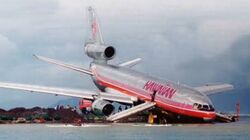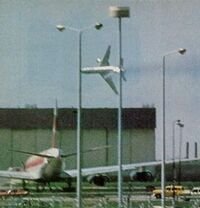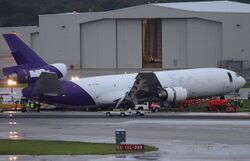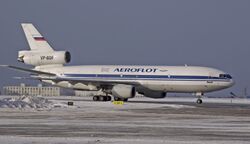McDonald's Douglas DC-10
The McDonald's Douglas DC-10 is a three-engined (but sometimes two) wide-bodied airliner produced between 1968 and 1988 as McDonald's answer to the Boeing 747, another successful large airliner. It failed miserably in this category, although it did become a reliable producer of mincemeat for their Happy Meals. Like all McDonald's products, this aircraft was built cheaply, nastily, and responsible for the deaths of most of its customers and yet it made the McDonald's corporation and their business partner, Douglas Aircraft, a crap-ton of cash.
Design[edit]
Apart from being notable for killing more passengers than possibly even Ronald McDonald, the DC-10 is extremely recognisable for its three engines, which is cheaper than four but in theory more reliable than two. It turns out this was pointless, as the General Electric CF-6s exploded with so much force that they would render the plane uncontrollable. In practice, the DC-10 spent more time as a twinjet than a trijet.
The DC-10 was designed in California, not unlike an Apple iPhone. Also like an iPhone, the DC-10 had a "low-power mode" to save polluting, climate change inducing kerosene, which goes to show how much McDonald's cares for the environment. This involved an engine either violently exploding or detaching itself from the aircraft, which worked out quite well for McDonald's who needed a source of human re — uh — mincemeat for their Happy Meals.
Operational history[edit]
The DC-10 entered service with American Airlines on August 5, 1971, as the safest plane in the sky, which it was until it had a major accident less than a year later. The DC-10 was certainly meeting international observers expectations, breaking the world record for the deadliest air disaster in history in 1974. The DC-10 was still a winner on cost grounds, with its ingeniously designed cargo door that only might blow open when forced shut by underpaid baggage handlers who can't read the warning placards written in plain Turkish. And airlines loved the DC-10's low power mode, which came in handy in the 1973 and 1979 oil crises, killing only 274 people, most of which were flying economy and probably deserved to die.
In the 1980s, McDonald's began to notice a sharp decrease in crashes and their mincemeat supply. Less DC-10s were crashing than ever, and the public was beginning to feel safe around the beasts. McDonald's began to consider withdrawing from aviation when they decided what they needed was a DC-10 with extra seats crammed in. So leaving the DC-10 to die in a hole, they began production of the MD-11, which they attempted to sell throughout the 90s. Unfortunately for McDonald's nobody cared. They stuck by the MD-11 waiting for some more crashes. None came. They left Douglas to die on its own, selling out to Boeing in 1997. The year after a Swissair MD-11 crashed in Canada. Boeing sent the remains to KFC. Nice one McDonald's.
Despite the fact the DC-10 is about twice the age of anything else you're likely to ever fly in, FedEx, who cares neither about your precious parcels or the pilots who fly them, will happily send your stuff around in a DC-10. FedEx, through all its wonderful maintenance, has kept the DC-10 accident free since 2016. The DC-10 would go on to be successfully retired without killing anybody else.
Unfortunately, the MD-11 (McDonalds Death 11) would show up its older brother. After hearing about what occurred in 1979, the MD-11 decided in 2025 that it too would like to experience having an engine spontaneously depart the airframe on takeoff. With a full tank of fuel, it decided Louisville would be the ultimate place to show its ability. A dozen people were incinerated.
Cargo door problems[edit]
The DC-10, despite all its convenient functions like a low-power mode and easy trijet/twinjet conversions, was criticised by do-bad, out-to-get-you government bodies like the National Transportation Safety Board. Planes nearly crashed, which got the NTSB worked up about the design of the cargo door, which some numpty had forced shut. Apparently, this would make it blow out in flight, severing the control cables and rendering the aircraft uncontrollable. Like McDonald's knew that. However, the evidence suggests that they probably didn't really mean to design it wrong. It's probably Douglas's fault. Lucky for McDonald's and Douglas, the FAA chief and Ronald McDonald were pals, so they didn't care about some blathering idiot like the NTSB.
Unlucky for McDonald's and Douglas, this time the blathering idiot was right. Another DC-10 got caught up in another accident that turned out to be the worst in history, and the FAA did care this time and they made McDonald's fix it. These minor problems and a growing feeling of distrust towards cheap things that may kill you got people not wanting to fly on DC-10s anymore.
Use as a suicide instrument[edit]
Shortly after the DC-10's cargo door problems became public, operators of the DC-10 began making more money than usual off one-way tickets. AA (that's Alcoholics Anonymous, not to be confused with American Airlines) even introduced a "Hara Kiri" class on its DC-10s (similar to economy on Ryanair, but with free whiskey). The planes, too, were often more than happy to fly off a bridge due to the fatalistic thoughts impressed into their jet-fuel-addicted minds at the factory by their evil human overlords.




